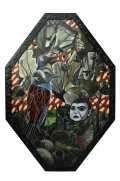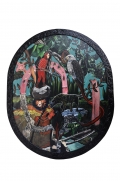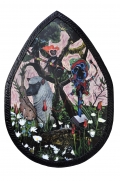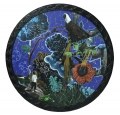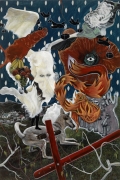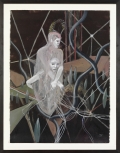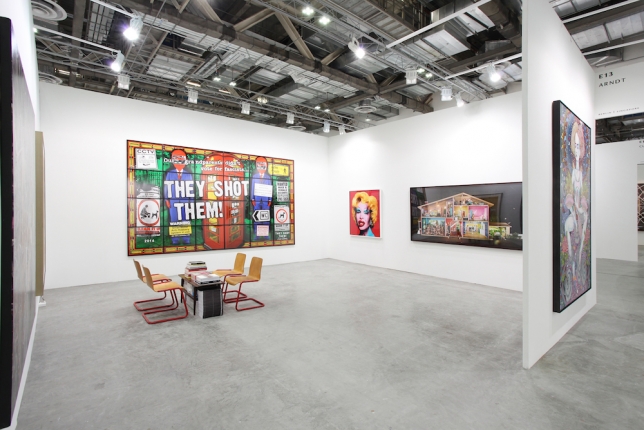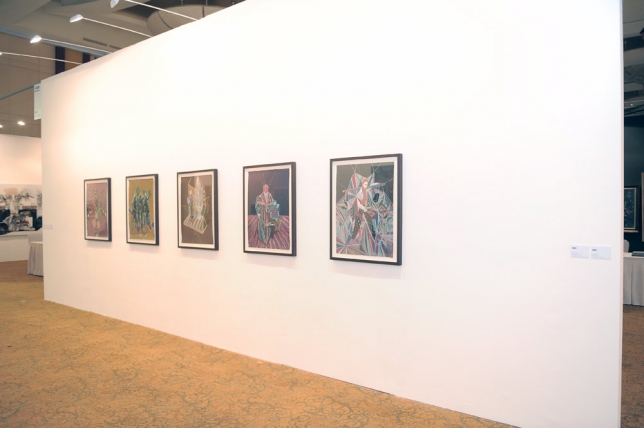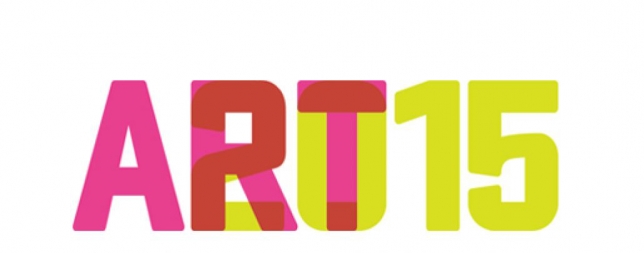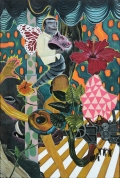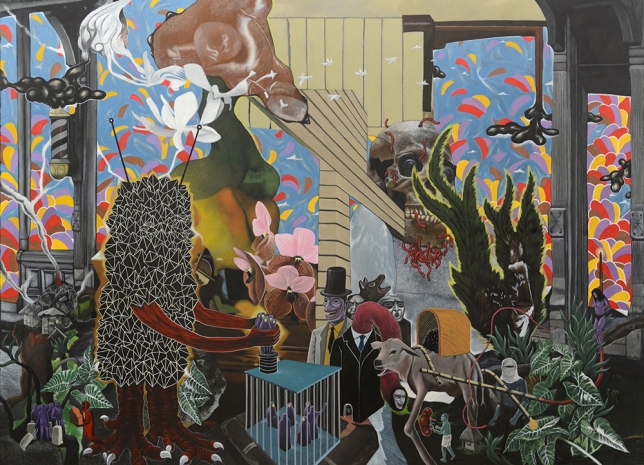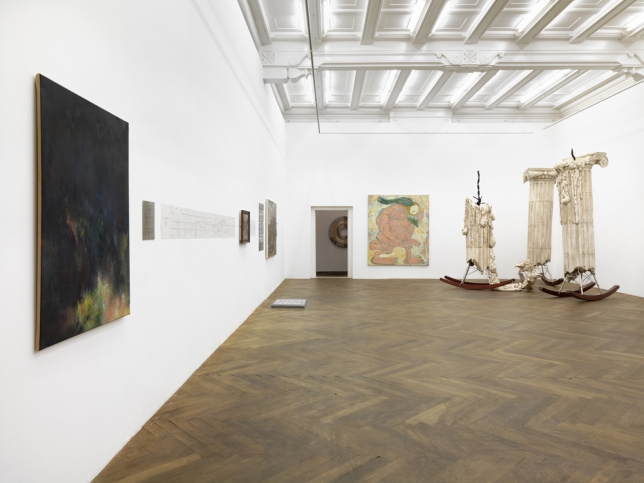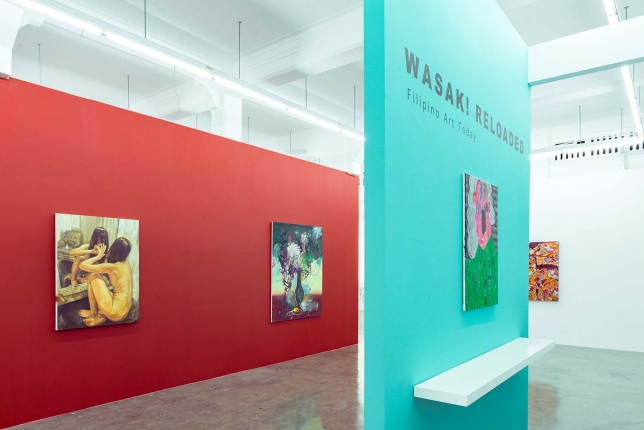RODEL TAPAYA
DIAMOND IN THE DISTANCE
Solo exhibition at ARNDT Singapore
September 13 - October 25, 2015
Opening | Saturday | September 12, 2015, from 4 - 7 pm | at ARNDT Singapore
ARNDT is pleased to present its first solo exhibition in Singapore by artist Rodel Tapaya.
Acres of Diamonds
Rodel Tapaya takes on the role of a miner and treasure hunter. With a renewed sense of adventure, he trudges on to seek and sift through local narratives for that precious gem — an elusive diamond that spells unparalleled good fortune.
Inspired by the stories woven in Russell Conwell’s “Acres of Diamonds”, Tapaya attempts to mediate between the interstices of what is valued and what is coveted.
“He said there once lived not far from the River Indus an ancient Persian by the name of Al Hafed. He said that Al Hafed owned a very large farm with orchards, grain fields and gardens. He was a contented and wealthy man—contented because he was wealthy…”
Al Hafed lived a comfortable life. One day, a priest paid him a visit and spoke of the cosmos, of granite, silver, gold and finally, diamond. For the first time, he felt like a poor man hungry for prosperity. The following day, he sold his farm and left his family in search for diamonds hidden underneath the white sand of a river flanked by two mountains. With high hopes and what money he had, he scoured the world. Alas, no bed of diamonds could be found. Eventually, his demise came in the form of a big tidal wave that sunk his dreams along with his remains.
The story takes an unexpected turn when Al Hafed’s successor chances upon a modest black stone at the bottom of the stream in his garden. Days pass and the same priest who spoke to Al Hafed visited his successor in his house. Upon seeing the stone atop the mantle, the priest identifies it as a diamond. Together, they went back to the garden and therein discovered what is now known as the magnificent diamond mines of Golconda.
Conwell’s oration is more than an exercise in rhetoric. The potency of the morals embedded therein is attested to by the number of times that his lecture cum sermon has been publicly delivered. And this perhaps is why Tapaya found it a fitting point of departure as he takes on once more the fantastical worlds in folk literature.
From a story teller to a diamond hunter
From multiple voices and points of origin, a narrative is hewn and transformed by the community. As these layers coalesce; as lines that define and delineate an author from his audience are blurred beyond recognition; here, a form of collective consciousness is fashioned in the process.
Enamoured by anthologies of myths and legends thoughtfully translated from numerous tongues and collected from various localities that outline the Philippines, Tapaya reconfigures the narratives into visual labyrinths on paper and canvas. Within the substantial segment of his decade-long art practice resting on these textual reserves, he has produced a wealth of works that mirror the enigmatic qualities of the stories he decides to tell.
The abstractness of myths and legends is somehow betrayed by the finality and two-dimensionality of the format. His paintings and larger murals are flat. Lines, curves and colors, characters and settings are confined within the four corners of his chosen surface. His paintings attempt to “tame”, contain and encapsulate a world that supersedes the physical and even visual depiction.
Orations come to pass. Mysterious apparitions necessitate instantaneity and brevity. Much like written documentation, Tapaya’s works endure, allowing what is imagined to take form and scenes made manifest to be surveyed at length. He is a story teller able to stretch time, even eludes it. In Diamonds in the Distance, this ability proves useful as he reframes his search for a thing that is as desirable as it is purportedly elusive.
With a host of narratives in tow, Tapaya is now a miner. As in the past, accuracy, soundness and logic are cast off along with nagging doubt. More than what is and should be of value, his hunt for treasure exposes the potency of the idea of having something that is worthy of such estimation.
The basis of his paintings, these myths and legends chart positionality and proximity. Is our life’s diamond within grasp, or is it something that begs to be chased after and pursued. In the same vein, these works offer a glimpse of a world-order that depends upon harnessing a power —may it be good will, or greed, luck, and even faith, among others — to arrive at a kind of life we yearn for, of a life well-lived.
Finding Diamonds
A lush forest is the site of an exciting quest. Separated in half, the upper torso of a man hovers as he sets his sight on a precious stone afar. In the raw, a diamond is opaque and rather misshapen. Once precisely cut, perfected and polished, this gem deserves nothing but adulation. Hit by light, a multitude of colors ricochet and dance onto adjacent surfaces.
In Tapaya’s Finding Diamonds, the man is akin to the Overseas Filipino Workers (OFWs) whose search takes them to distant shores. Arguably to this day, the proverbial American (or another) Dream rings true still for some. Al Hafed, who spent his remaining days looking for hidden treasures elsewhere, died without seeing the dazzling glare, not knowing that a mine of diamonds is within reach.
In Regain the Fire, protrusions line the bottom of the canvas. A hostile volcano towers over calm mountains — a preview to a Bikolano tale that speaks of good ties gone sour — severed. In the story, Gugurang, god of good, resides in Mayon Volcano while Asuang, the god of evil, in Mount Malinao. The former reigned as the supreme deity of Bikolanos. Revered by all, Gugurang was the good god who punishes wrong doings. He showed his might with the rumbling of the volcano. He showed his indignation and resolve when fiery lava would spew out of the crater.
With a pang of envy, Asuang asked Gugurang for some of his fire. Gugurang refused, for he said that such power was not easy to control. He argued his case but Gugurang was firm. Infuriated, Asuang plotted to steal the fire, a sign of a war waged. With his cunning ways, he was able to successfully steal it. Then again, he quickly noticed that the world around him caught fire. As he passed, everything burned until all was black. Determined to turn things right, Gugurang tried desperately to steal it back.
As fate would have it, Gugurang regains control of the fire and his people. As punishment, he sent down a great deluge, thunder and lightning towards Mount Malinao. When calm was restored, people noticed that Mount Malinao was seemingly halved, while Mayon Volcano stood pristine.
Accepted in faith, myths speak of events that happened in the past, giving insight to the present. Punishment and misfortune befall the wicked, while good will and deeds are rewarded with prosperity. In her compilation of myths, Damiana Eugenio sites Malinowski:
“Myth as it exists in a savage community, that is in its living primitive form, is not merely a story told but a reality lived. It is not the nature of fiction…but is a living reality, believed to have once happened in primeval times, and continuing ever since to influence the world and human destinies. This myth is to the savage what, to the fully believing Christian, is the Biblical story of Creation, of the Fall, of the Redemption by morality, as it governs our faith and controls our conduct, even so does his myth for the savage…Myth…expresses …enhances, and codifies beliefs; it safeguards and enforces morality; it vouches for the efficiency of ritual and contains practical rules for the guidance of man.”
Most of the time prescriptive, myths and even legends go beyond ascertaining and codifying beliefs and morals. They speak of a realism that somehow assuages the dreariness of earthly life. Everyone desires something. Everyone works at the betterment of life. In Tapaya’s previous exhibition Bato-Balani, I wrote:
“It is the truth that nothing is without cost, the credence of the well-known adage that warns “be careful what you wish for” that is of import in a world where everyone covets; and where gods and goddesses, mortals, animals and other fanciful creatures are leveled by their wanting.”
Overlooked and hidden treasures
In his works, he ferrets out occasions where treasures need not be defined by tactility, lustrous qualities or even rarity. Tapaya believes that most often, true and enduring riches are within our midst. They come in the form of relationships and ties we nurture and keep, and even unwavering convictions that calibrate our views and steer actions. All of these extend beyond the confines of the self, bleeding into the broader context of community and the country.
The Helpful Crocodile is a work based on a tale from Ilocos wherein a young woman is enslaved by three witches. Working on her chores, Maria finds a young crocodile near the body of water where she washes dirty dishes. Unknown to her, the crocodile she decided to take care of possessed supernatural powers. One day, the now adult crocodile overheard the evil plan of the witches to eat Maria. To help her escape, the crocodile instructed her to plant a bamboo on its back. As a makeshift anchor, she safely sailed until the bank was reached. The crocodile asked her to sever a branch of the bamboo and plant it at the site where they parted as a reminder of their unexpected friendship.
In the exhibition, another large scale acrylic painting commands attention. Entitled Slave Broker, the work is a mirage of colors, figures and tableaus. An avian creature is concealed behind sharp and angular feathers. Locked in its hands are grim faces, folks about to be slid into a cramped cage.
The work is inspired by recent events surrounding a former overseas Filipina worker who was placed under death row after she was accused of attempting to smuggle heroin. Her story is but one of many cases of widespread human trafficking across borders. Preying on desperation, recruiters and organized crime syndicates subject them to incredulous conditions. With everything to lose, and without a countermove, they plummet into desolation.
Clad in a white barong, the man with butterfly wings clings onto a pig’s head. While he eyes a gumamela nearby, he concocts a plan. With a sinister smile, it is ascertained; things will be set in motion.
In Philippine politics, the figure of a swine is a stand in for corrupt politicians. With the 2016 National Elections fast approaching, Butterfly Carnival is Tapaya’s take on the loose and often relationship-driven political party system in place. Two-faced gimmickry, disloyalty and cheap prizes abound in this carnival of sorts. With sheer ambition, relations fostered stand in ruin.
Beyond myths and legends
In Diamond in the Distance, Tapaya includes works on paper that are departures from his large scale canvas paintings, as well as from the aesthetic of assemblages that is distinct in his recent works. With restraint, a focal point is apparent. Whimsy takes a step back in favor of the banality of the everyday.
Rounding of his mediation, Tapaya compels us to sort the essential from the frivolous, and those that can be set free and reclaimed. In times fraught with devastation, mundane possessions are magnified and turned precious. Scenes from the onset and aftermath of storms, immense and widespread floods, even demolition of homes and being uprooted show of precarious states.
Tapaya’s tapestry of images speaks volumes of conditions that cut across worlds that are imagined and real. His ability to blur the lines that separate them, spot parallels and then weave them seamlessly has proven useful in abstracting a quintessential truth about being human. In his search for life’s diamonds, a line from Conwell’s story about Al Hafed resonates well with Tapaya’s recent works – an enduring gem that will never lose its luster: “He was a contented and wealthy man…wealthy because he was contented.”
Text by Thea Garing
Gillman Barracks
9 Lock Road #03-21
Singapore 108937
Tel. +65 67340775
info@arndtfineart.com

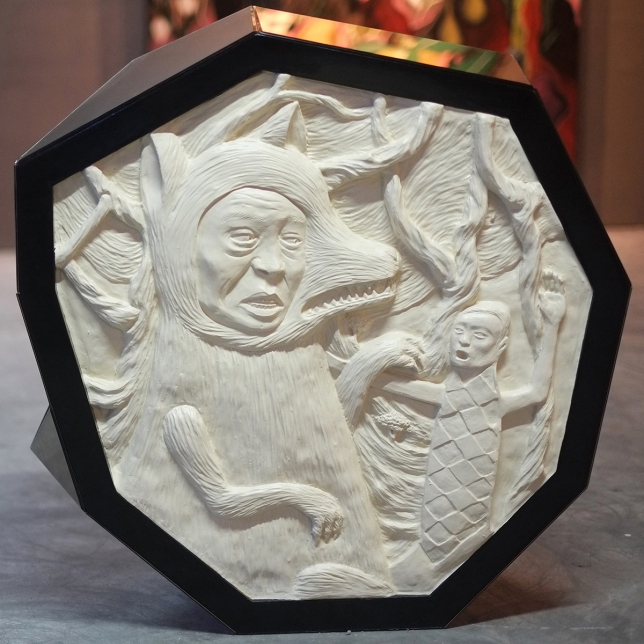
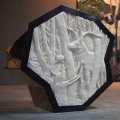
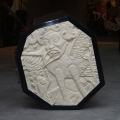
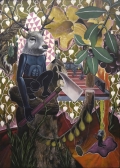
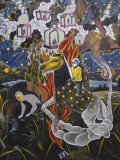











![Rodel Tapaya, Modern Manananggal, 2013, Wood, brass, silver, fiberglass, encaustic and assorted materials Size: variable, fourteen figures [7 male: 7 female] This work will be hanged from the ceiling [upper body], # TAPA0027](cms/application/include/views/smarty/cache/60f1a5eaf5f6a9a8662f4b0e2daf81d8.jpg)

